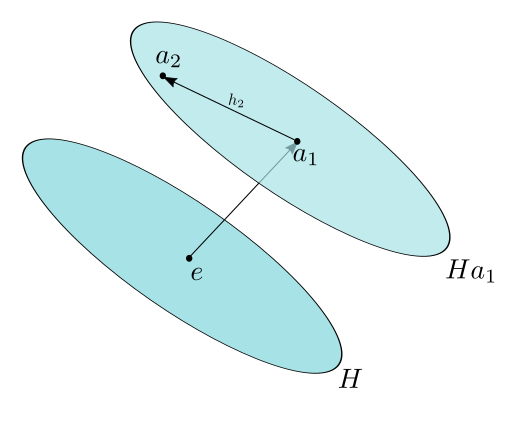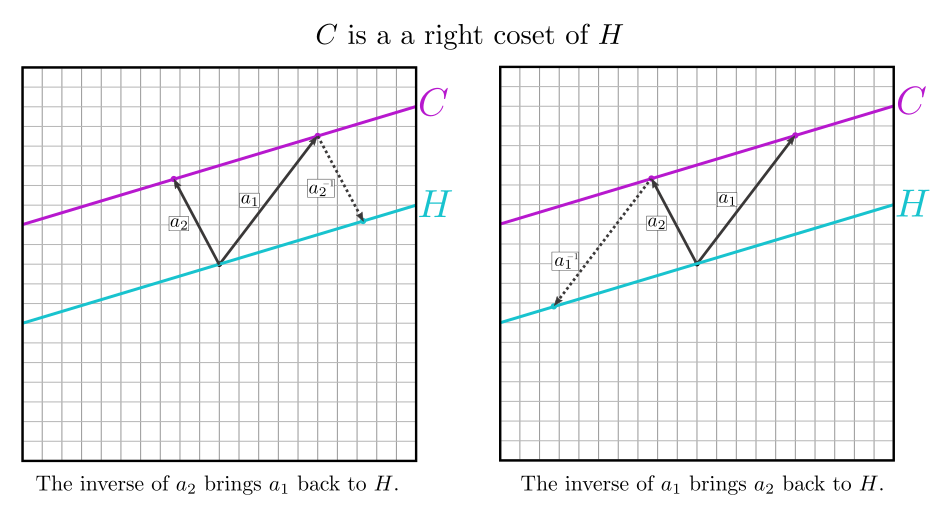Cosets
Coset
Let \( G \) be a group and \( H \subset G \) a subgroup.
For any \( a \in G \), a right-coset of \( H \) is any set of the form:
For any \( a \in G, \) a left-coset of \( H \) is any set of the form:
Coset equivalence relation
A right-coset forms a block in a partition defined by an equivalence relation, \( \sim_{R} \).
A left-coset forms a block in a partition defined by a equivalence relation, \( \sim_{L} \).
The essence of the relations is to consider an element related to another if the inverse of one element brings the other element back to \( H \).
The quotient group property
The equivalence relation above that defines a partition of right cosets satisfies an important property. An in fact, this property can define the equivalence relation, assuming a fixed subgroup \( H \). This property appears on the LHS below:
The property also asserts that \( H \) is the equivalence class of \( e_{G} \).
\( \sim_R \) is a valid equivalence relation
Shown for the right coset equivalence relation,
We can show that the above relation is reflexive, symmetric and transitive.
- We have \( xx^{-1} = e \in H \), so \( x \sim x \).
- If \( x \sim y \), then \( xy^{-1} \in H \). Observe that \( (xy^{-1})^{-1} = yx^{-1} \), and this element is in \( H \), as \( H \) is closed under the group operation.
- If \( x \sim y \) and \( y \sim z \), then we have \( xy^{-1} \in H \) and \( yz^{-1} \in H \). Concatenating through the group operation we have \( xy^{-1}yz^{-1} = xz^{-1} \), and this term is in \( H \), again as \( H \) is closed under the group operation.
The same line of reasoning also applies to \( \sim_L \).
The partitions of \( \sim_R \)
A block in the partition corresponding to \( \sim_R \) can be expressed in terms of \( H \) and a single term from the class.
Proof. Let \( A \) be one of the equivalence classes. If we fix an element \( a \in A \), then any element \(x \in A \) has the property that \( xa^{-1} = h \), for some \( h \in H \). In other words, \( x = ha \). With \( x \) being arbitrary, this property is enough to define \( A \): any element having this property is in \( A \), and any element in \( A \) is \( \sim_{\text{equivalent} \) to \( a \) and has this property.
The same line of reasoning also applies to \( \sim_L \). Thus, any subgroup \( H \) of \( G \) is associated with 2 partitions of \( G \).
Intuition #1

The idea is to consider any element of \( a_2 \in Ha_1 \) as being expressible as \( h_2 a \) for some \( h_2 \in H \). We are breaking \( a_2 \) into two components \( h_2 \) and \( a_1 \). With this, it is easy to see that \( h_2 \) can be reached by \( a_2 a^{-1} \).

Visualization

Alternative treatment
The material is presented in the reverse order in this intuitive post: https://math.stackexchange.com/a/1128688/52454.
Intuition
Intuition for why:
Consider \( x = e_G \). The equivalence class of \( e_G \) maps to the subgroup \( H \). Now consider \( g = a \) and then \( g = b \). For \( g = a \), we must have \( \forall h \in H, ha \sim a \). If this is not clear, note that \( a \sim e_G \sim a \), then apply the LHS of the implication above. Thus, all elements \( Ha \) are in an equivalence class. The same applies to \( Hb \).
Now consider what happens if we assert that \( a \sim b \). As an equivalence relation is transitive, all elements \( Ha \) and \( Hb \) must also be equivalent.
A visualization of this idea is shown below.

Not that this reasoning doesn't explain why \( Ha \) includes every element equivalent to \( a \). One must show why it's not possible for an element \( v \in G \) to exist and for \( v \sim a \) but \( v \notin Ha \). To explain this, we note that \( v \sim a \) implies that \( va^{-1} \sim e_G \), which in turn means that there exists some \( h \in H \) such that \( ha = v \). Thus we have \( v \in Ha \).
